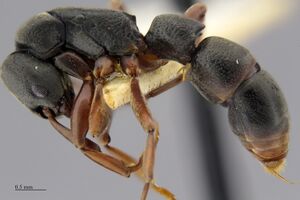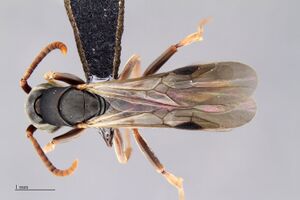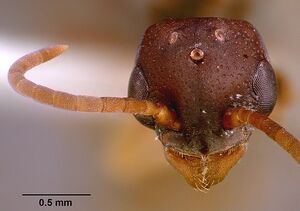Platythyrea modesta
| Platythyrea modesta | |
|---|---|

| |
| Scientific classification | |
| Kingdom: | Animalia |
| Phylum: | Arthropoda |
| Class: | Insecta |
| Order: | Hymenoptera |
| Family: | Formicidae |
| Subfamily: | Ponerinae |
| Tribe: | Platythyreini |
| Genus: | Platythyrea |
| Species: | P. modesta |
| Binomial name | |
| Platythyrea modesta Emery, 1899 | |
An arboreal foraging species. Nests are polygynous, contain up to 50 workers and occupy pre-exiting cavities in rough bark or dead branches in trees and Cubitermes spp. termitaries situated at the bases of trees in old and secondary forests. Their swiftness enables the workers to capture a wide variety of insects, including agile or large individuals. (Djieto-Lordon et al. 2001)
| At a Glance | • Gamergate |
Identification
Keys including this Species
Distribution
Latitudinal Distribution Pattern
Latitudinal Range: 22° to -31.3°.
| North Temperate |
North Subtropical |
Tropical | South Subtropical |
South Temperate |
- Source: AntMaps
Distribution based on Regional Taxon Lists
Afrotropical Region: Cameroun (type locality), Central African Republic, Democratic Republic of Congo, Equatorial Guinea, Gabon, Ghana, Ivory Coast, Kenya, Mozambique, Nigeria, Saudi Arabia, South Africa, Sudan, Uganda.
Palaearctic Region: Oman.
Distribution based on AntMaps
Distribution based on AntWeb specimens
Check data from AntWeb
Countries Occupied
| Number of countries occupied by this species based on AntWiki Regional Taxon Lists. In general, fewer countries occupied indicates a narrower range, while more countries indicates a more widespread species. |

|
Estimated Abundance
| Relative abundance based on number of AntMaps records per species (this species within the purple bar). Fewer records (to the left) indicates a less abundant/encountered species while more records (to the right) indicates more abundant/encountered species. |

|
Biology
Studying prey/foraging behavior in this species, Djieto-Lordon et al. (2001) found: In Platythyrea modesta, an arboreal foraging ponerine ant, single workers mastered large prey, but were unable to retrieve them. They therefore recruited nestmates that either carved up the prey on the spot, and then solitarily retrieved pieces of prey, or consumed a part of the prey directly. Nevertheless, in most situations entire prey were consumed on the spot by recruited workers that, in certain cases, even transported larvae from the nest to the prey. In nature, the latter behavior resembles emigration.
Castes
       
| |
| . | Owned by Museum of Comparative Zoology. |
   
| |
| . | |
   
| |
| . | |
Nomenclature
The following information is derived from Barry Bolton's Online Catalogue of the Ants of the World.
- modesta. Platythyrea modesta Emery, 1899e: 467 (w.) CAMEROON.
- Type-material: lectotype worker (by designation of Brown, 1975: 45).
- Type-locality: Cameroon: (no further data), 1895 (Conradt).
- Type-depositories: MHNG (lectotype); MHNG, MSNG (other original syntypes).
- Wheeler, G.C. & Wheeler, J. 1976a: 41 (l.).
- Status as species: Stitz, 1910: 129; Emery, 1911d: 29; Stitz, 1916: 371; Forel, 1916: 398; Wheeler, W.M. 1922a: 760; Menozzi, 1942: 166; Eidmann, 1944: 430; Brown, 1975: 8, 45; Collingwood, 1985: 240; Bolton, 1995b: 336; Collingwood & Agosti, 1996: 310; Hita Garcia, et al. 2013: 221; Borowiec, L. 2014: 147.
- Distribution: Cameroon, Democratic Republic of Congo, Equatorial Guinea, Gabon, Ghana, Ivory Coast, Kenya, Oman, Saudi Arabia, South Sudan, Uganda, Yemen.
Description
References
- Borowiec, L. 2014. Catalogue of ants of Europe, the Mediterranean Basin and adjacent regions (Hymenoptera: Formicidae). Genus (Wroclaw) 25(1-2): 1-340.
- Brown, W. L., Jr. 1975. Contributions toward a reclassification of the Formicidae. V. Ponerinae, tribes Platythyreini, Cerapachyini, Cylindromyrmecini, Acanthostichini, and Aenictogitini. Search Agric. (Ithaca N. Y.) 5(1 1: 1-115 (page 45, see also)
- Djiéto-Lordon, C., J. Orivel, and A. Dejean. 2001. Consuming large prey on the spot: the case of the arboreal foraging ponerine ant Platythyrea modesta (Hymenoptera: Formicidae). Insectes Sociaux. 48:324-326.
- Emery, C. 1899d. Fourmis d'Afrique. Ann. Soc. Entomol. Belg. 43: 459-504 (page 467, worker described)
- Radchenko, A.G., Fisher, B.L., Esteves, F.A., Martynova, E.V., Bazhenova, T.N., Lasarenko, S.N. 2023. Ant type specimens (Hymenoptera, Formicidae) in the collection of Volodymyr Opanasovych Karawajew. Communication 1. Dorylinae, Poneromorpha and Pseudomyrmecinae. Zootaxa, 5244(1), 1–32 (doi:10.11646/zootaxa.5244.1.1).
- Wheeler, G. C.; Wheeler, J. 1976a. Supplementary studies on ant larvae: Ponerinae. Trans. Am. Entomol. Soc. 102: 41-64 (page 41, larva described)
- Zéphirin, T., Leila, B.B., Chantal, A.D., Champlain, D.-L. 2019. Recruitment Rate of Nestmate in Six Tropical Arboreal Ants (Hymenoptera: Formicidae). Journal of Insect Behavior 32, 252–266 (doi:10.1007/s10905-019-09731-y).
References based on Global Ant Biodiversity Informatics
- Borowiec L. 2014. Catalogue of ants of Europe, the Mediterranean Basin and adjacent regions (Hymenoptera: Formicidae). Genus (Wroclaw) 25(1-2): 1-340.
- Brown W. L., Jr. 1975. Contributions toward a reclassification of the Formicidae. V. Ponerinae, tribes Platythyreini, Cerapachyini, Cylindromyrmecini, Acanthostichini, and Aenictogitini. Search Agric. (Ithaca N. Y.) 5(1): 1-115.
- Collingwood, C. A. and D. Agosti. 1996. Formicidae (Insects: Hymenoptera) of Saudi Arabia (Part 2) Fauna of Saudi Arabia 15: 300-385.
- Collingwood, C. A., and Donat Agosti. "Formicidae (Insecta: Hymenoptera) of Saudi Arabia (Part 2)." Fauna of Saudi Arabia 15 (1996): 300-385.
- Eidmann H. 1944. Die Ameisenfauna von Fernando Poo. 27. Beitrag zu den Ergebnissen der Westafrika-Expedition. Zool. Jahrb. Abt. Syst. Ökol. Geogr. Tiere 76: 413-490.
- Garcia F.H., Wiesel E. and Fischer G. 2013.The Ants of Kenya (Hymenoptera: Formicidae)Faunal Overview, First Species Checklist, Bibliography, Accounts for All Genera, and Discussion on Taxonomy and Zoogeography. Journal of East African Natural History, 101(2): 127-222
- Hita Garcia, F., G. Fischer, M.K. Peters, R.R. Snelling and H.W. Wagele. 2009. A preliminary checklist of the ants (Hymenoptera: Formicidae) of Kakamega Forest (Kenya). Journal of East African Natural HIstory 98(2): 147-165.
- IZIKO South Africa Museum Collection
- Lévieux J. 1972. Les fourmis de la savane de Lamto (Côte d'Ivoire): éléments de taxonomie. Bulletin de l'Institut Fondamental d'Afrique Noire. Série A. Sciences Naturelles 34: 611-654.
- Menozzi C. 1942. Formiche dell'isola Fernando Poo e del territorio del Rio Muni (Guinea Spagnola). 24. Beitrag zu den wissenschaftlichen Ergebnissen der Forschungsreise H. Eidmann nach Spanisch-Guinea 1939 bis 1940. Zoologischer Anzeiger 140: 164-182.
- Sharaf M. R., B. L. Fisher, H. M. Al Dhafer, A. Polaszek, and A. S. Aldawood. 2018. Additions to the ant fauna (Hymenoptera: Formicidae) of Oman: an updated list, new records and a description of two new species. Asian Myrmecology 10: e010004
- Sharaf M. R., H. M. Al Dhafer, and S. A. Aldawood. 2014. First record of the myrmicine ant genus Meranoplus Smith, 1853 (Hymenoptera: Formicidae) from the Arabian Peninsula with description of a new species and notes on the zoogeography of Southwestern Kingdom Saudi Arabia. PLoS ONE 9(11): e111298 (doi:10.1371/journal.pone.0111298).
- Tadu Z., C. Djieto-Lordon, R. Babin, Yede, E. B. Messop-Youbi, and A. Fomena. 2013. Influence of insecticide treatment on ant diversity in tropical agroforestry system: some aspect of the recolonization process. International Journal of Biodiversity and Conservation 5(12): 832-844.
- Taylor B. 1976. Ants of the Nigerian Forest Zone (Hymenoptera: Formicidae). I. Ponerinae, Cerapachyinae, Pseudomyrmecinae. Cocoa Research Institute of Nigeria Technical Bulletin Series 4: 1-41.
- Wheeler W. M. 1922. Ants of the American Museum Congo expedition. A contribution to the myrmecology of Africa. VIII. A synonymic list of the ants of the Ethiopian region. Bulletin of the American Museum of Natural History 45: 711-1004
- Yeo K., and A. Hormenyo. 2007. A Rapid Survey of Ants in Ajenjua Bepo and Mamang River Forest Reserves, Eastern Region of Ghana. Pp 27-29. In McCullough, J., P. Hoke, P. Naskrecki, and Y. Osei-Owusu (eds.). 2008. A Rapid Biological Assessment of the Ajenjua Bepo and Mamang River Forest Reserves, Ghana. RAP Bulletin of Biological Assessment 50. Conservation International, Arlington, VA, USA.

